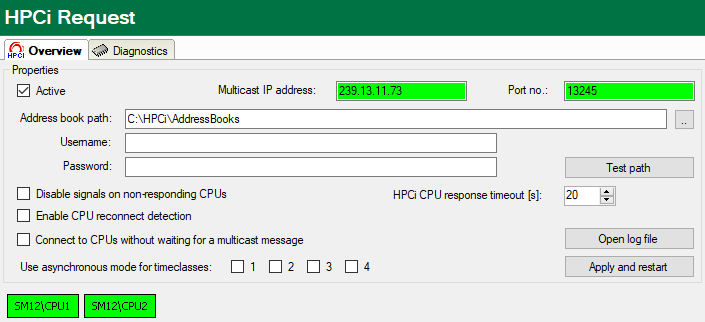
On the one hand, this tab provides status information, on the other hand, the user can enter configuration data.
Active
Check this option if you want to use the interface.
Multicast IP address and Port no.
Display of the multicast IP address and port number as configured in the configuration
file (toc.ini). The address and port no. should be assigned to the ibaPDA system in the HPCi / DGM200 system configuration.
ibaPDA sends its request messages to the HPCi stations by multicast via this IP address and port number.
Address book path
Enter the complete path name where the toc.ini configuration file is stored.
The file toc.ini is created by the P80i address book generator or edited manually.
User name and password
If the file toc.ini is not stored on the local hard disk of the ibaPDA-PC but on a network drive, it might be necessary to enter here the user name and
password of a user account, which can be used by the ibaPDA-PC for login on the remote computer. This user account should be sufficiently authorized
for data access on the remote computer.
<Test path>
Press this button in order to check the accessibility of the specified path.
Disable signals of non-responding CPUs
At start of the measurement, all CPUs (in the HPCi stations) are polled. If a CPU is not responsive, the related signals will be disabled and the acquisition will start without these signals, provided this option is enabled.
The use of this option is recommended during commissioning or maintenance works, if some HPCi stations are unavailable.
If this option is not enabled, the measurement will not start until all CPUs have replied to the polling at start of measurement.
HPCi CPU response timeout [s]
This setting specifies the waiting time of idle communication until a CPU is considered as "non-responding". You may adjust this value to your requirements.
Enable CPU reconnect detection
If this option is enabled, missing CPUs will be checked also during the measurement. If a missing CPU is available again or restarts, the measurement will be stopped, a new request will be sent and the measurement will be restarted.
Connect to CPUs without waiting for a multicast message
When this option is enabled, ibaPDA will establish a unicast connection to each CPU, based on the IP address in the toc.ini file, as soon as possible. The option is disabled by default.
Generally, when starting the acquisition, ibaPDA waits for multicast messages sent by the CPUs before establishing the connection. In some cases the multicast messages can be delayed significantly due to network problems, particularly in networks with routers or switches using IGMP Snooping.
Use asynchronous mode for timeclasses
The asynchronous mode setting for the time classes determines when the driver of ibaPDA will copy data from the boards. If asynchronous mode is off then the data is copied during the interrupt service routine. If asynchronous mode is on then the data is copied on a separate thread outside of the interrupt service routine. Normally asynchronous mode should be off. Asynchronous mode is only needed when the interrupt service routine takes more than 1000 µs to copy all the data from the boards. You can check this by going to the General tab and the Interrupt info node.
<Open log file>
Mouse click this button in order to open a system log file which shows all relevant activities and events regarding the connection to the HPCi systems.
<Apply and restart>
If changes were made in this dialog, confirm them with this button. The changes will be applied and the driver restarted.
All detected HPCi stations, i. e. those registered in the address book file, will be represented by colored blocks in the lower part of the dialog box.
The colors refer to the following states:
-
green = control path (TCP/IP connection) and data path (DGM200) OK.
-
yellow = control path (TCP/IP connection) OK, data path (DGM200) not OK.
-
red = not connected with station, e. g. when station is switched off